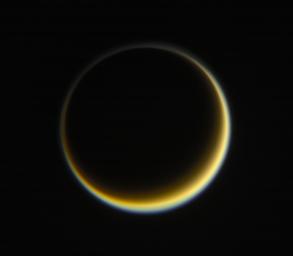
|
Highlighting Titan’s Hazes
- Click the image above for a larger view
- Full-Res JPEG (836 x 731) (17.4 kB)
- Full-Res TIFF (836 x 731) (692.3 kB)
Caption:
NASA's Cassini spacecraft looks toward the night side of Saturn's moon Titan in a view that highlights the extended, hazy nature of the moon's atmosphere. During its long mission at Saturn, Cassini has frequently observed Titan at viewing angles like this, where the atmosphere is backlit by the Sun, in order to make visible the structure of the hazes.
Titan's high-altitude haze layer appears blue here, whereas the main atmospheric haze is orange. The difference in color could be due to particle sizes in the haze. The blue haze likely consists of smaller particles than the orange haze.
Images taken using red, green and blue spectral filters were combined to create this natural-color view. The image was taken with the Cassini spacecraft narrow-angle camera on May 29, 2017. The view was acquired at a distance of approximately 1.2 million miles (2 million kilometers) from Titan. Image scale is 5 miles (9 kilometers) per pixel.
Background Info:
The Cassini mission is a cooperative project of NASA, ESA (the European Space Agency) and the Italian Space Agency. The Jet Propulsion Laboratory, a division of Caltech in Pasadena, manages the mission for NASA's Science Mission Directorate, Washington. The Cassini orbiter and its two onboard cameras were designed, developed and assembled at JPL. The imaging operations center is based at the Space Science Institute in Boulder, Colorado.
For more information about the Cassini-Huygens mission visit https://saturn.jpl.nasa.gov and https://www.nasa.gov/cassini . The Cassini imaging team homepage is at https://ciclops.org .
Cataloging Keywords:
| Name | Value | Additional Values |
|---|---|---|
| Target | Titan | Saturn |
| System | Saturn | |
| Target Type | Satellite | Planet |
| Mission | Cassini-Huygens | |
| Instrument Host | Cassini Orbiter | |
| Host Type | Orbiter | |
| Instrument | Imaging Science Subsystem (ISS) | |
| Detector | Narrow Angle Camera | |
| Extra Keywords | Atmosphere, Color, Haze, Visual | |
| Acquisition Date | ||
| Release Date | 2017-08-11 | |
| Date in Caption | 2017-05-29 | |
| Image Credit | NASA/JPL-Caltech/Space Science Institute | |
| Source | photojournal.jpl.nasa.gov/catalog/PIA21625 | |
| Identifier | PIA21625 | |
